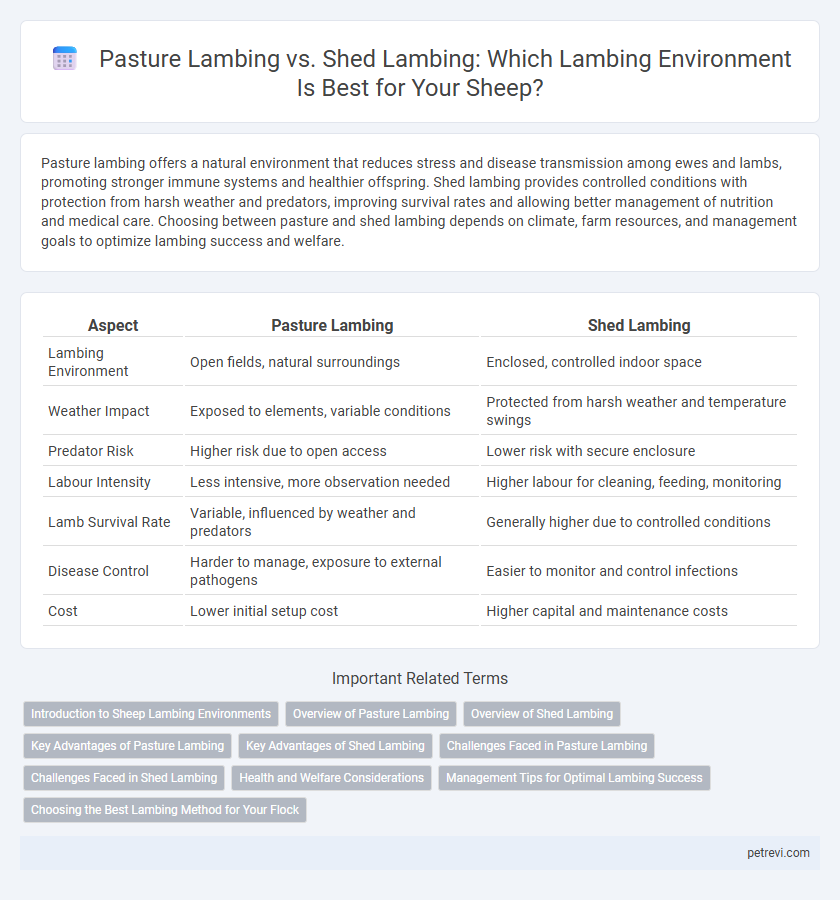Pasture lambing offers a natural environment that reduces stress and disease transmission among ewes and lambs, promoting stronger immune systems and healthier offspring. Shed lambing provides controlled conditions with protection from harsh weather and predators, improving survival rates and allowing better management of nutrition and medical care. Choosing between pasture and shed lambing depends on climate, farm resources, and management goals to optimize lambing success and welfare.
Table of Comparison
| Aspect | Pasture Lambing | Shed Lambing |
|---|---|---|
| Lambing Environment | Open fields, natural surroundings | Enclosed, controlled indoor space |
| Weather Impact | Exposed to elements, variable conditions | Protected from harsh weather and temperature swings |
| Predator Risk | Higher risk due to open access | Lower risk with secure enclosure |
| Labour Intensity | Less intensive, more observation needed | Higher labour for cleaning, feeding, monitoring |
| Lamb Survival Rate | Variable, influenced by weather and predators | Generally higher due to controlled conditions |
| Disease Control | Harder to manage, exposure to external pathogens | Easier to monitor and control infections |
| Cost | Lower initial setup cost | Higher capital and maintenance costs |
Introduction to Sheep Lambing Environments
Pasture lambing allows ewes to give birth in natural outdoor settings, promoting natural behavior and airflow, which reduces the risk of respiratory diseases. Shed lambing provides a controlled, sheltered environment with easier access for monitoring and intervention during lambing, ensuring protection from harsh weather and predators. Choosing between pasture and shed lambing depends on flock size, climate conditions, and management goals to optimize lamb survival and ewe welfare.
Overview of Pasture Lambing
Pasture lambing involves ewes giving birth outdoors in natural grazing areas, providing a more natural and spacious environment that can reduce disease transmission and stress. This method requires careful management of pasture quality, predator control, and monitoring to ensure lamb survival and ewe health. Optimal pasture conditions and timely assistance during lambing are critical to maximize lamb growth and ewe reproductive success.
Overview of Shed Lambing
Shed lambing provides a controlled environment that protects lambs and ewes from harsh weather, predators, and disease, which can significantly improve lamb survival rates. The indoor setting allows for closer monitoring, timely intervention during difficult births, and better hygiene management compared to pasture lambing. This method often results in higher lambing percentages and improved overall flock health due to reduced exposure to environmental stressors.
Key Advantages of Pasture Lambing
Pasture lambing offers key advantages such as reduced risk of disease transmission and natural environmental conditions that promote healthier lamb growth. Sheep experience lower stress levels in outdoor settings compared to confined shed environments, leading to improved maternal behavior and higher lamb survival rates. Additionally, pasture lambing minimizes labor and infrastructure costs by utilizing natural shelter and grazing resources.
Key Advantages of Shed Lambing
Shed lambing provides a controlled environment that reduces exposure to harsh weather, minimizing lamb mortality and improving overall health. It allows for easier monitoring and intervention by farmers, ensuring timely assistance during difficult births. Enhanced hygiene in shed settings decreases the risk of infections, promoting better growth rates and stronger lambs compared to pasture lambing.
Challenges Faced in Pasture Lambing
Pasture lambing exposes ewes and lambs to unpredictable weather, increasing the risk of hypothermia and lamb mortality. Predation by wild animals and difficulties in monitoring lambing progress complicate timely intervention and care. Grazing terrain variability can lead to complications during birthing and challenges in locating newborn lambs for essential aftercare.
Challenges Faced in Shed Lambing
Shed lambing presents challenges such as increased risk of disease transmission due to confined spaces and limited ventilation. Maintaining optimal temperature and hygiene requires constant management to prevent stress and infections in newborn lambs. Additionally, labor intensity and costs are higher compared to pasture lambing, requiring more infrastructure and monitoring.
Health and Welfare Considerations
Pasture lambing offers a natural environment that reduces stress and promotes stronger immune systems in lambs through increased exposure to fresh air and natural hygiene conditions. Shed lambing allows for better control over temperature, predator protection, and easier monitoring of ewe and lamb health, reducing mortality rates during harsh weather. Balancing environmental exposure and biosecurity measures is crucial to optimize lamb health and welfare during the lambing period.
Management Tips for Optimal Lambing Success
Pasture lambing requires careful monitoring to protect ewes and lambs from predators and adverse weather, emphasizing regular checks and shelter availability, while shed lambing offers controlled conditions that reduce exposure to environmental stressors but demand strict hygiene and ventilation management. Optimal lambing success depends on selecting a strategy suited to herd size, climate, and available resources, alongside nutrition supplementation and minimizing ewe stress. Maintaining accurate records and providing prompt assistance during lambing further enhance survival rates and overall flock health.
Choosing the Best Lambing Method for Your Flock
Pasture lambing promotes natural ewe behavior and reduces labor costs by allowing lambing in open fields, which supports better ventilation and minimizes disease risk. Shed lambing offers controlled environmental conditions, better protection from predators, and easier monitoring, especially in regions with extreme weather or high predation. Choosing the best lambing method depends on flock size, climate, predator presence, and available labor resources to optimize lamb survival and ewe health.
Pasture Lambing vs Shed Lambing for Sheep Lambing Environment Infographic

 petrevi.com
petrevi.com